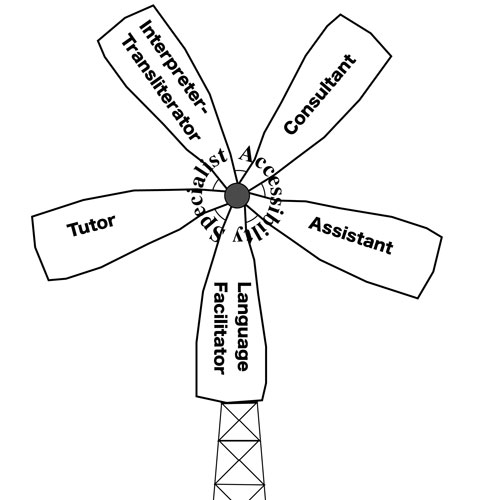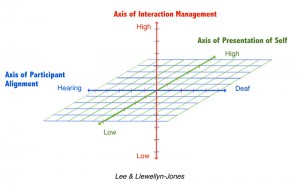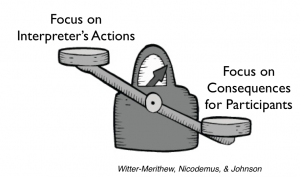 Workshop Description
Workshop Description
For students using sign language in mainstream settings, interpreters play a significant role in the effectiveness of an educational team. Too often, though, these teams don’t have the opportunity to discuss what interpreters can and should be doing to promote student growth and development. In part, this is due to a legacy of the interpreting profession that held to a rigid role. (Does the phrase, “I can’t do that because of the Code of Ethics” sound familiar?) More recently, interpreters have begun to realize that this approach has frequently contributed to negative results.
This session, with both large group presentation and small group discussions, will focus on emerging understandings of best practices for interpreters in the classroom that most effectively support student achievement – and how to carry this conversation forward with other members of the educational team.
Objectives
- List the three dimensions of interpreter role-space as described by Lee & Llewellyn-Jones
- Describe the difference between deontological and teleological ethics
- Explain factors affecting an interpreter’s’ ethical choices
- Analyze a case study to evaluate options for different interpreting approaches
"Part of the Team" Resources
Educational Interpreting
Resources Related to Educational Interpreting
The National Association of Interpreters in Education

The National Association of Interpreters in Education (NAIE) is a professional organization for interpreters in educational settings established in 2016. http://naiedu.org/
 More than Meets the Eye: Revealing the Complexities of an Interpreted Education
More than Meets the Eye: Revealing the Complexities of an Interpreted Education
by Melissa B. Smith
http://gupress.gallaudet.edu/bookpage/MTMEbookpage.html
View the Ph.D. Dissertation this book is based on here.
Dr. Smith did a lecture at Gallaudet University on this topic.
You can see all of the presentations archived by Gallaudet University Regional Interpreter Education Center here.
Understanding the Impact of Interpretability in Mainstream Classrooms
This chapter by Betsy Winston lays out the limitations for rigid understandings of interpreting in classroom settings.
Winston, B. 2004. “Interpretability and Accessibility of Mainstream Classrooms,” In Educational Interpreting: How it Can Succeed. Gallaudet University Press. See the article.
Articles about Educational Interpreting
New Paradigms in the Interpreted Classroom: An article written by Doug Bowen-Bailey for the RID Views -(in press August 2014)
Ethical Choices: Educational Sign Language Interpreters as Change Agents
Perspectives from Gina Oliva
Dr. Oliva is the author of “Alone in the Mainstream” sharing her experience as an “only” going through mainstreamed settings – as well as some of her research about other deaf people who went through the mainstream in a similar way.
- Sign Language Interpreters in Mainstream Classrooms: Heartbroken and Gagged
An article on Street Leverage. Check it out. - K-12 Interpreters: A Call to Arms for Sign Language Interpreter Programs
An article on StreetLeverage. Check it out.
Determining a Student’s Readiness to Successfully Use Interpreting Services
This is an article from Cindy Huff, a teacher of the Deaf/Hard of Hearing, about a framework for assessing if students are at a developmental level appropriate for benefiting from an interpreted education.
Language Acquisition
The link below has a presentation in ASL about the Common Errors of Young Children Acquiring Sign Language, helpful information in seeing what is normal language development.
Providing Access: New Roles for Educational Interpreters
By Bernhardt E. Jones, Ed.D., C.S.C.
Originally published in the RID VIEWS
Conflicts can, and do, occur when it is unclear as to the interpreter’s role at any given time. This function changes during the day, especially in the lower grades. I am suggesting (as has Winston) that the title, “educational interpreter” is too narrow, and, in fact, this position is a multi-faceted responsibility. If this is true, how do we separate the roles? How do we define what it is that we do and when?
A year ago Winston (Views) did a fine job in delineating educational interpreting responsibilities into three roles: interpreting, tutoring and aiding. Since then, Winston has discussed the notion that consulting is also a role that educational interpreters play. Consulting may be a new area that you had not considered before. But, think about all the times you have given your input in the school situation. How many times have you talked to parents? How many times have you explained “deafness” to others in the school? to students? to administrators? to regular education teachers? You may find that this list is long. Go to the dictionary or, better, go to the Web and search the word, “consulting” or “consultant” and see what you find. Do you fit into this definition during part of the time you are working in the school setting?
The public school educational interpreter is viewed quite often as a paraprofessional and, in fact, is categorized that way in many states. However, we can make the case that, although the interpreter does perform many of the duties of the paraprofessional, she/he also performs a duty that is quite different and requires separate and distinct knowledge and skills: interpreting itself. Are we not, then, more than an educational interpreter? Might we be, to use a term that Winston has expressed, an “Accessibility Specialist?” I don’t want to confuse the issue with additional terms for us, but think about the variety of tasks you perform. Perhaps we are not “just the interpreter,”but we are more than the interpreter.
Take a look at your day (or week or month, if you would like). Make a list of all the duties you perform. Try to think of everything that happens in your job. What do you do? How long do you do it? Make the list as long and comprehensive as you can. You should have a collection of everything you do. You may be surprised to see that you do quite a bit for the school and the students (both deaf/hard of hearing and hearing).
The Windmill Model

Note: The graphic has been updated since the article was written so it does not perfectly correspond to the article.
The next step is to draw your own windmill and categorize the duties/tasks that you have listed. Interpreting will include anything you do in the role of an interpreter. Tutoring will include all the tasks you do within that context. Aiding is a large and varied area or responsibility. Think of all the things you do in an aiding capacity. As discussed above, consulting is also an important role of the educational interpreter.
Isn’t this appropriate? A windmill spins in the wind and must be flexible (accommodating) in order to operate effectively and efficiently. If one of the blades is broken or damaged, the windmill will not operate properly. Are we like that?
I suggest that we are. With this model we can delineate our roles. When we are able to do that, we can better understand why dilemmas cause conflict. Conflict arises when we are not sure on which blade to categorize our dilemma. We are better able to handle conflict if we know the rules by which to address the conflict. When conflict arises, we know where it fits and, therefore, we know how to respond (how to “spin” our windmill). [I guess it depends upon who is blowing on our windmill.] The blades of the windmill can be viewed as contexts. When we know the contexts, we know the rules. This is where the Code of Ethics has caused us concerns. When applied to the interpreting blade (role, context) of the model, it is easy to understand the importance of the Code and to adhere to its principles. When we apply those same criteria to the other blades (roles), it becomes cloudy and appears to conflict with the role. The problem is compounded if other professionals do not know our contexts and/or confuse our contexts (roles, blades). We then can apply the “educating others about our role(s)” principle of the Code by explaining our contexts and the roles to others on the educational team. The other members of the educational team will not realize this by themselves. We have a professional obligation to educate our fellow professionals. By doing so, we will be viewed as professionals.
This is only the beginning. When we understand which role we are working within, we can start addressing bigger questions in our field. These questions might involve questions of interpretability in the classroom, accessibility to content, an interpreted education. These questions impact our windmill and, therefore services to students who are deaf and hard of hearing.
Information about the Educational Interpreter Performance Assessment
This site provides information both about the test and about the expectations for interpreters working in educational settings. classroominterpreting.org
Guides for Classroom Interpreting for Parents, Professionals, and Students
Dr. Brenda Schick, the co-creator of the EIPA, along with Boys Town, created a series of guides for the Laurent Clerc National Deaf Education Center.
Training in Interpreting Public Schools (TIPS)
TASK12: This is the organization that led to the development of the Training in Public Schools (TIPS) module. The project serves 14 states and provides both training and assessment with the EIPA.
Post-Secondary & Transition Resources:
The Minnesota Transition Guide for Teachers of Deaf/Hard of Hearing was created as a pilot project for the school year 2012 – 2013. It is meant to give guidance in the area of transition for Deaf or Hard of Hearing students. View Transition Guide.
PEPnet: An organization focused assisting Deaf and hard of hearing students in their transition to post-secondary education. They have a module, Map It!, that is designed as a support for students in the transition stages.
Article from 2003 RID Views
Theory of Mind
Developing a Theory of Mind
Brenda Schick, in a chapter in the book, Educational Interpreting: How It Can Succeed, explains how the developing of a Theory of Mind (ToM) is related to educational development for students and how that can be impacted by receiving schooling through an interpreter. Theory of Mind is defined by Wikipedia as “the ability to attribute mental states—beliefs, intents, desires, pretending, knowledge, etc.—to oneself and others and to understand that others have beliefs, desires, intentions, and perspectives that are different from one’s own.”
Schick argues that an important part of children developing this ability is to see how people talk about certain topics – recognizing that different people will display different emotions. Receiving information through an interpreter can distort the ability to see/hear how other people are conveying information. Based on the EIPA scores of approximately 1,3000 interpreters, she notes the average prosody score for elementary interpreters was 2.8 for elementary interpreters and 3.0 for secondary interpreters. (Many states recognize 4.0 as an overall score denoting being qualified to work in classrooms.) Schick writes of this situation:
Ironically, elementary-aged deaf and hard of hearing children with hearing families, who are likely to be delayed in their Theory of Mind skills and who are still developing their understanding of how minds work, may have the least amount of information in the classroom interpretation to figure out register and identity of the speaker. (pp 77-78)
Interpreters working with students developing a ToM need to be particularly aware of identifying who is speaking in the classroom and providing information about how someone is talking about the topic and what might be the underlying meaning to the message conveyed by the prosodic nature of the discourse. Schick gives the example of a teacher “issuing a warning to finish seatwork by saying ‘It’s getting close to reeecceeesss,’ meaning ‘you may not get to go out if you don’t finish.'” Note that in this example, the teacher’s pronunciation of the word “recess” is elongated giving it a different meaning than is contained by the word on its face. If an interpreter doesn’t include that prosody, then a student would not have access to the actual meaning of the phrase.
So, another important thing for interpreters in educational settings to attend to in helping support the educational development of students who are deaf, deafblind, and hard of hearing.
Schick, B. “Learning through an interpreter,” (pp 73-87) in
 Educational Interpreting: How it Can Succeed
Educational Interpreting: How it Can Succeed
Edited by Elizabeth Winston
View more information on Gallaudet University Press web site.
 Not What You Say, But How
Not What You Say, But How
See a more extended consideration of Theory of Mind and its implications for educational interpreters in a blog post I wrote for MRID. Click here to see the post.
Demand-Control Schema
Publications
The work by Robyn Dean and Robert Pollard has facilitated a fundamental shift in the interpreting profession from a deontological sense of ethics to a more teleological one. If you are curious about what that means, check out their web site at: Demand-Control Schema
From their web site, you can contact Robyn Dean for the latest information. It is important to recognize that understandings of the Demand-Control Schema is not static. Dean & Pollard are continuing to refine the application of DC-S so be sure to look for the most up-to-date publications and materials.
The latest article from Dean and Pollard which contains the most updated formulation of the Demand-Control Schema in an article format.
Dean & Pollard, 2012. Context-based Ethical Reasoning in Interpreting: A Demand Control Schema Perspective. The Interpreter and Translator Trainer, 5(1) 2011, 155-82.
You can access more of Dean’s publications here.
Webinars & Videos
MARIE Center Webinars
Robyn Dean did a series of webinars in 2014 for the MARIE Center as part of the NCIEC. These are presented in spoken English with captioning and ASL interpretation.
Videos as Part of NCIEC Mentoring Toolkit
Robyn Dean and Bob Pollard created a series of ASL videos explaining the Demand-Control Schema. (These are created in ASL without any English translation.) See those videos under the heading “Robyn Dean.”
Additional Resources
Facebook: get updated information here.
Observation-Supervision: Here’s a blog post from Robyn Dean about the important of developing these groups for observation-supervision.
 Text Book: In 2013, Robyn Dean and Robert Pollard published a textbook on Demand-Control Schema. You can order a copy here.
Text Book: In 2013, Robyn Dean and Robert Pollard published a textbook on Demand-Control Schema. You can order a copy here.
A Resource on Tacit Schemas for Ethical Decision-Making
Rest, J.R., Navarez, D., Bebeau, M., and Thoma, S.J. (1999). Postconventional moral thinking: A neo-Kohlbergian approach. Mahwah, NJ: Lawrence Erlbaum Associates.
Role-Space
The most complete treatment by Robert Lee and Peter Llwellyn-Jones is in their book:
Re-Defining the Role of the Community Interpreter: The concept of role-space. 2014. Lincoln, UK: SLI Press. View on Amazon.
- The presentation from Robert Lee and Peter Llewellyn-Jones from the CIT Conference
- A paper from Supporting Deaf People conference in 2011
- A video explanation in ASL of this concept by Robert Lee – created for the Gallaudet University Regional Interpreter Education Center
Relational Autonomy
 Relational Autonomy – Presentation by Anna Witter-Merithew & Brenda Nicodemus
Relational Autonomy – Presentation by Anna Witter-Merithew & Brenda Nicodemus
Blog Posts on Street Leverage on related topics by Anna Witter-Merithew:
- Sign Language Interpreters: Stepping Out of the Shadow of Invisibility
- Sign Language Interpreters: Are Acts of Omission a Failure of Duty?
- Sign Language Interpreters: Breaking Down Silos Through Reflective Practice
 Nurse Autonomy as Relational by Chris MacDonald (Contact Doug for further information)
Nurse Autonomy as Relational by Chris MacDonald (Contact Doug for further information)



